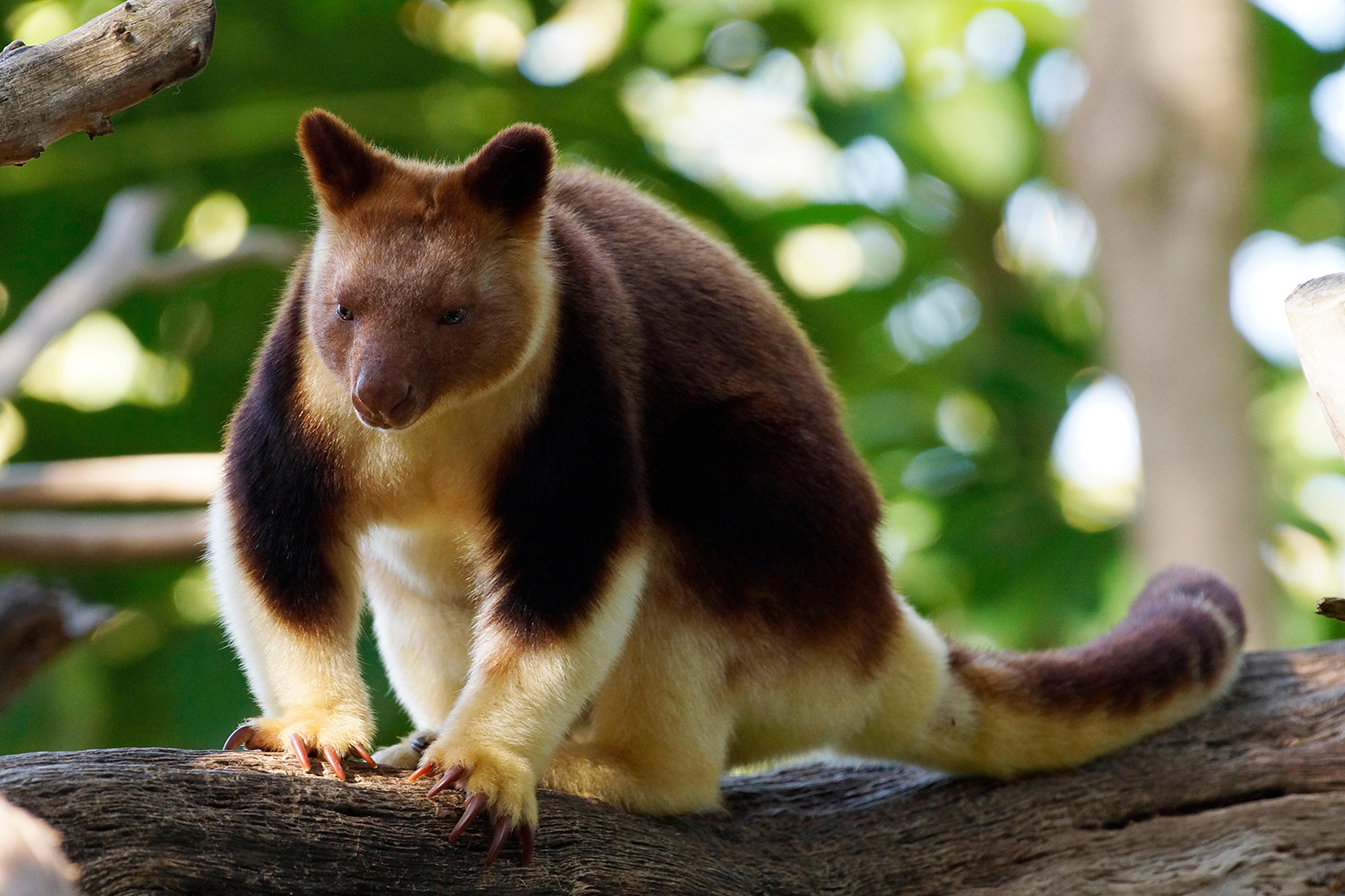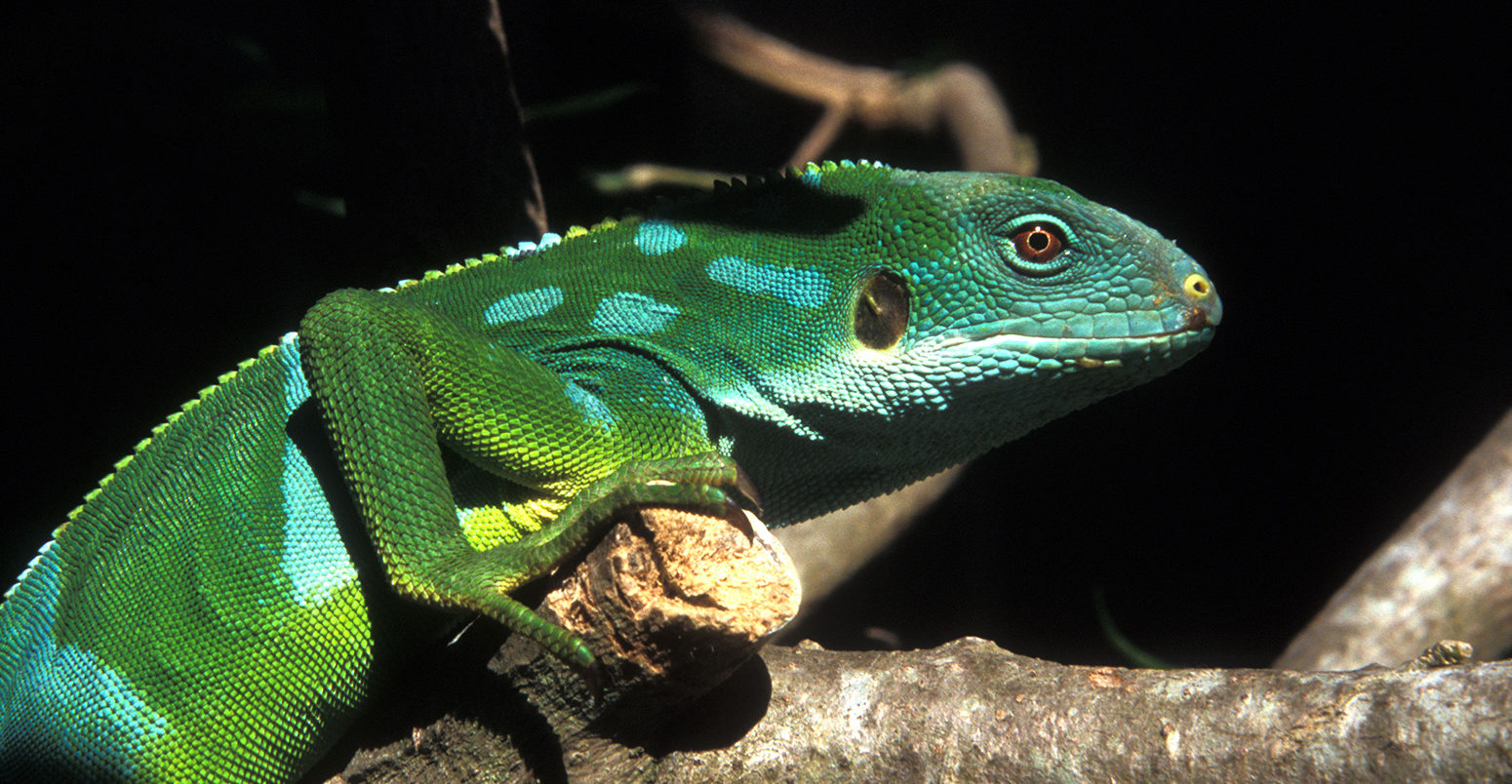
Rising seas threaten scores of species on Pacific islands with extinction
Robert McSweeney
07.13.17Robert McSweeney
13.07.2017 | 2:00pmThe Chuuk flying fox. The Black-spotted Cuscus. The Fijian crested iguana. The Mariana skink. The greater monkey-faced bat. Poncelet’s giant rat.
Not exactly household names, but these creatures have something in common: they’re all critically endangered and they all live on islands in the Pacific Ocean that are at high risk from rising sea levels.
That’s the conclusion of a new study, published in the Nature journal Scientific Reports, which maps the distribution of 150 threatened species living on Pacific islands and their susceptibility to sea level rise.
Some of these creatures are found on just a single island, so losing their habitats to encroaching seas would mean global extinction, the lead author tells Carbon Brief.
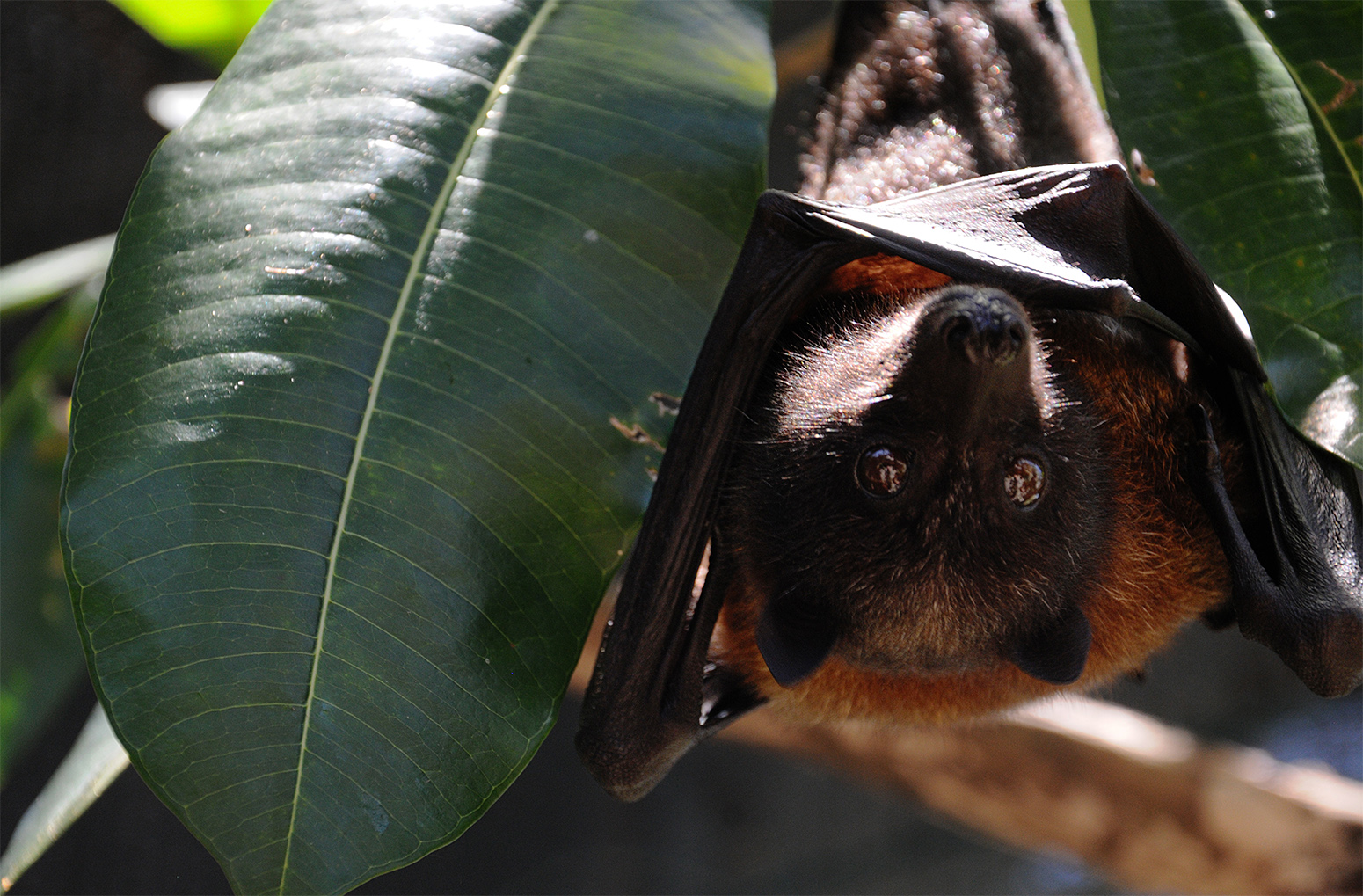
A Mariana fruit bat named Babydoll hangs from a tree at the Guam National Wildlife Refuge in Guam May 20, 2013. The Mariana fruit bat (Pteropus mariannus) is currently listed as a threatened species. (U.S. Air Force photo by Staff Sgt. Melissa B. White/Released)
Low-lying islands
The new study focuses on a stretch of the southern Pacific Ocean from Palau in the west to the Pitcairn Islands in the east. Within this 85m square kilometre (sq km) area are more than 2,000 islands.
These islands come in all shapes and sizes – most are volcanic or reefs – but they are predominantly small and low-lying. Their average size is just 1.3 sq km – some are just a tenth of that size – and 42% of them have a maximum elevation of less than 10m.
These characteristics put the islands – and the species that live on them – at particular risk from sea level rise, storms and high waves, the study says.
On small islands, land-based creatures have fewer places to move to when their habitats are lost. In addition, through evolution, many island-living species no longer have the traits that would have helped them move on – for example, many birds and insects have lost their ability to fly.
Putting all these factors together, species living on these Pacific islands are “highly vulnerable to extinction”, the paper says.
Indeed, the 1,779 islands assessed in the study area are home to 150 amphibians, mammals and reptiles that feature on the International Union for Conservation of Nature’s (ICUN) Red List of Threatened Species. Fifty-one of these species are classed as “Vulnerable”, 61 as “Endangered” and 38 in the most at-risk category of “Critically Endangered”.
Eighty-four of the 150 species aren’t found anywhere else on Earth. Fifty-four of them – such as the Giant Bandicoot, the Goodfellow’s tree-kangaroo and the Taom Striped Gecko – can only be found on a single island. Eleven species live on two islands and the remaining 29 live on three or more.
Susceptibility
Using distribution data for the 150 species, the researchers mapped their locations across the islands. They then classified the “susceptibility” of each island to rising sea levels according to its size, elevation, shape and the hardness/softness of its rock.
In general, a small, low, narrow sandy island will usually be more vulnerable than a large, high, round volcanic island, explains lead author Prof Lalit Kumar from the University of New England in Australia. He tells Carbon Brief:
“Islands that are of sandy/coral origin, that have low elevations, that are small in size and those that are thin and long are the most susceptible to climate change. Of course, there are other factors, such as where they are located – tropical cyclone paths, significant wave heights, etc – that will also impact the susceptibility.”
You can see the results in the map below. The circles indicate islands that are home to at least one of the 150 threatened species. The colour of the circle shows how susceptible that island is to rising sea levels. The empty circles highlight islands that do not host any of the species.
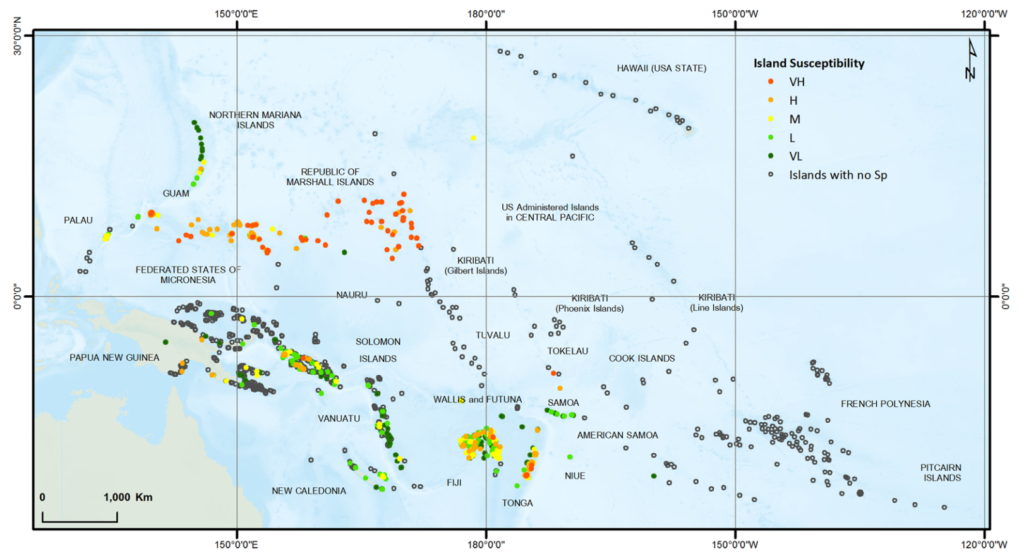
Map of Pacific Ocean islands and threatened species. The circles indicate island that host at least one vulnerable, endangered or critically endangered terrestrial vertebrate species. The colour of the filled circles indicate that island’s susceptibility rankings, from very high (red) to very low (dark green). Empty circles are islands that do not host any of the threatened species. Source: Kumar & Tehrany (2017)
Of the 1,779 islands, 674 were home to at least one of the 150 threatened species. Of these, the study classified 59 islands as having “very high” susceptibility to rising seas, followed by 178 for “high”, 152 for “medium”, 171 for “low” and 114 for “very low”.
Among the islands most susceptible to sea level rise are those of Tonga, Micronesia and the Marshall Islands.
Global extinction
![]()
Using climate model projections of sea level rise and wave heights, the researchers mapped the regional risks of the islands being inundated with seawater. Local variations in wind patterns, ocean currents and sea surface temperatures mean that sea level change won’t be the same across the region.
The map below shows the regional sea level risks under a climate change scenario where global CO2 emissions aren’t curbed (RCP8.5). The risk is categorised according to the maximum sea level for any month during the average year at the end of the century (against a baseline of 1986-2005).
The coloured circles show the islands that host threatened species. The background shading indicates the risk from rising seas, from low (green) to very high (red).
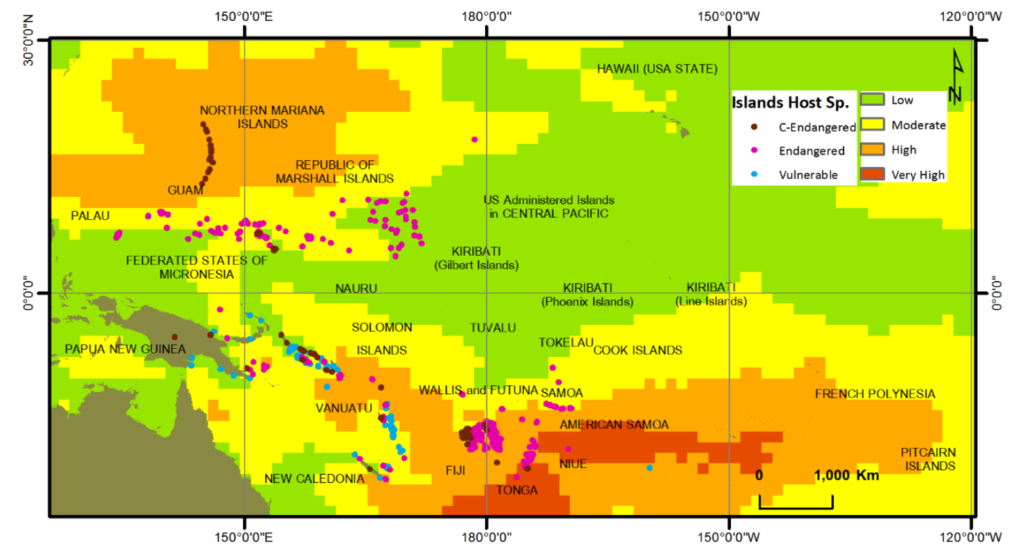
Map of sea level rise risk and threatened species on Pacific Ocean islands. The coloured circles indicate island that host at least one vulnerable (blue), endangered (pink) or critically endangered (brown) terrestrial vertebrate species. The background shading indicates sea level rise risk, from low (green) to very high (red) under RCP8.5 for 2081-2100, compared to a baseline of 1986-2005. Source: Kumar & Tehrany (2017)
The map highlights that some of the islands that are home to critically endangered species are at high risk from rising seas, the paper says:
“The Northern Mariana Islands, islands in Fiji, Tonga and New Caledonia host most of the critically endangered species, and Fiji, Tonga and the Northern Mariana Islands all fall in the high and very high categories under RCP 8.5 projections.”
Combining the susceptibility of the island with the risk from sea level rise, the study finds that the islands of Micronesia, Tonga, Tokelau and the Marshall Islands are the riskiest place for species to live. These islands are not home to any “critically endangered” species, but they are for many “endangered” species.

Fijian Crested Iguana, Brachylophus vitiensis, Kula Eco Park, Viti Levu, Fiji. Credit: Douglas Peebles Photography / Alamy Stock Photo.
The study concludes that many of these species may need to be reclassified as critically endangered. If they are lost from these islands, they will be lost to the world, warns Kumar:
“These species are only found in this region of the world and so deserve extra attention since a loss of any of these species will mean global extinction.”
These sorts of studies that help identify species under threat from climate change are crucial to directing limited conservation money to where it is needed most, says Dr Mark Urban, associate professor in the Department of Ecology and Evolutionary Biology at the University of Connecticut, who wasn’t involved in the study.
But research methods also need to take into account the specific biology and habitat of individual species and the threats they face, he tells Carbon Brief:
“We will need to accelerate our knowledge of the world’s natural history as rapidly as climate change advances or we risk losing it entirely.”
Update 14 July: Comments added from Dr Mark Urban.
Kumar, L. and Tehrany, M. S. (2017) Climate change impacts on the threatened terrestrial vertebrates of the Pacific Islands, Scientific Reports, doi:10.1038/s41598-017-05034-4


